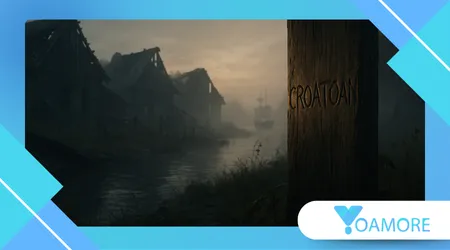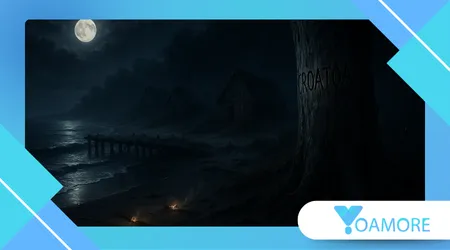The Lost Colony of Roanoke: America’s First Unsolved Mystery

Keyword: Roanoke Colony disappearance appears from the very first line.
Anúncios
Between England’s dream of New World expansion and the untamed wilderness of early America lies one of the nation’s most enduring enigmas: the mysterious Roanoke Colony disappearance.
This article delivers a comprehensive, updated narrative—covering origins, leading theories, recent archaeological evidence, historical implications, and expert analysis. Each section is crafted with clarity, credibility, and depth to meet 2025’s standards for factual storytelling.
What Was the Roanoke Colony and Why Did It Become a Mystery?
In 1587, under the sponsorship of explorer Sir Walter Raleigh, a group of roughly 112 to 121 English settlers established a colony on Roanoke Island, located off the coast of present-day North Carolina. Their goal was to found the first permanent English settlement in the Americas.
When Governor John White returned three years later in 1590, the site was abandoned. Houses were dismantled, belongings vanished, and only one clue remained: the word “CROATOAN” carved into a wooden post. Thus began one of history’s great unsolved stories — the Roanoke Colony disappearance.
Anúncios
++The Great Molasses Flood: When Boston Drowned in Syrup
When and Why Did the Disappearance Occur?
Soon after the settlers arrived on Roanoke Island, optimism quickly gave way to hardship. Food supplies dwindled, relations with some local tribes became strained, and the colony’s isolation left it vulnerable to every storm and seasonal change.
The settlers relied heavily on incoming ships from England, yet none arrived for years.
Political turmoil across the Atlantic only worsened their plight. England was embroiled in the Anglo-Spanish War, diverting ships and resources that had been promised to Governor John White.
When White finally returned in 1590, after a delay of nearly three years, he discovered an eerily silent settlement. Buildings were dismantled rather than destroyed, suggesting an orderly departure rather than an attack.
The only clue—“CROATOAN” carved into a wooden post—hinted that the colonists may have sought refuge with the nearby Croatan tribe on Hatteras Island.
Yet no definitive evidence confirmed their fate. This moment, recorded in White’s journal, has since become one of the defining enigmas of early American history.
In the centuries since, historians have viewed these missing years not as a sudden tragedy but as a slow unraveling driven by environmental collapse, political neglect, and desperate human adaptation.
The Roanoke Colony disappearance therefore reflects both the dangers of colonization and the resilience of those who tried to endure it.
++The Forgotten Rebellion of the Spartacus Slave Army
What Are the Main Theories Explaining the Vanishing?
Over centuries, historians have proposed multiple explanations for the Roanoke Colony disappearance. Below are the leading interpretations based on recent research and evidence.
1. Starvation, Drought, and Disease
Dendrochronology studies show that between 1587 and 1589, one of the worst droughts in 800 years struck the Outer Banks region.
Crops failed, trade with local tribes declined, and hunger likely forced desperate measures. This remains the most accepted environmental cause, though it doesn’t explain where the colonists went.
2. Conflict or Capture
Another theory suggests that the colonists were attacked—either by hostile tribes or Spanish soldiers operating nearby. Yet the lack of any physical evidence—no burned structures, no remains—makes this theory less convincing.
3. Assimilation With Indigenous Tribes
Perhaps the most compelling hypothesis holds that survivors joined the Croatan people (later known as the Hatteras tribe).
Archaeological finds back this up. In 2024, researchers uncovered Tudor-era ceramics and hammerscale (iron-working fragments) at Hatteras Island — suggesting cultural exchange and cohabitation.
4. Relocation to Chesapeake Bay
Some historians argue that the settlers moved north to Chesapeake Bay or other areas along the Virginia coast. Unfortunately, no confirmed settlement has yet been linked to the Roanoke colonists.
++The Forgotten French Revolution That Happened in Haiti
What New Evidence Has Emerged by 2025?
Recent research has reinvigorated this centuries-old investigation, blending archaeology, climate science, and forensic technology.
| Year | Discovery | Significance |
|---|---|---|
| 1998 | Tree-ring data revealed a severe drought from 1587–1589 | Confirms environmental collapse as a likely trigger. |
| 2017–2020 | Hatteras excavations uncovered Tudor ceramics, weapon fragments, and hammerscale. | Strong evidence of English presence within an Indigenous site. |
| 2025 | Metal artifacts dated to the late 1500s found at “Site X.” | Reinforces the assimilation theory through material culture. |
Collectively, these findings suggest the colonists did not simply vanish. Instead, they may have adapted, intermarried, or integrated into neighboring tribes—leaving behind a hybrid cultural footprint. Researchers caution, however, that the mystery remains partially unresolved.
Why the Mystery Still Matters in Understanding English Colonization

The Roanoke Colony disappearance reshapes how we interpret early colonial history.
- It highlights the fragility of England’s first transatlantic experiments—decades before Jamestown or Plymouth.
- It reframes colonization not solely as dominance but as cultural adaptation and survival.
- It underscores the power of interdisciplinary research—from dendrochronology to DNA studies—in rewriting history.
- It humanizes the story of early contact, revealing how settlers and Indigenous peoples may have coexisted in ways long overlooked.
- Finally, it reflects on how national myths and unresolved pasts continue to shape identity today.
A 2025 feature by Colonial Williamsburg emphasized that the case serves as both a historical mystery and a lesson in resilience, showing how myths can evolve into windows of understanding.
Conclusion
The story of Roanoke stands as more than an archaeological puzzle—it’s a metaphor for human endurance and uncertainty. The Roanoke Colony disappearance remains a symbol of ambition colliding with nature and cultural complexity.
While modern evidence increasingly supports the idea of assimilation with local tribes, complete certainty eludes scholars. That uncertainty, paradoxically, may be what keeps Roanoke alive in public imagination.
Each new artifact unearthed reminds us that history is not static but a living dialogue between evidence and curiosity.
To explore this subject further, consult these trusted sources:
- Encyclopedia Britannica – The Lost Colony of Roanoke
- U.S. National Park Service – Major Theories of the Lost Colony
Frequently Asked Questions
1. Who founded the Roanoke Colony?
It was organized by Sir Walter Raleigh and led by Governor John White in 1587.
2. How many people disappeared?
Between 112 and 121 settlers vanished after the colony’s establishment.
3. What does “CROATOAN” mean?
It refers to a nearby island (now Hatteras Island) and the Croatan tribe, possibly indicating where the settlers relocated.
4. Was Roanoke the first English colony in the Americas?
Yes. Roanoke marked England’s first attempt at a permanent settlement, preceding Jamestown by two decades.
5. Has the mystery been solved?
Not completely. Current evidence leans toward assimilation rather than extinction, but definitive proof of the colonists’ fate remains elusive.
